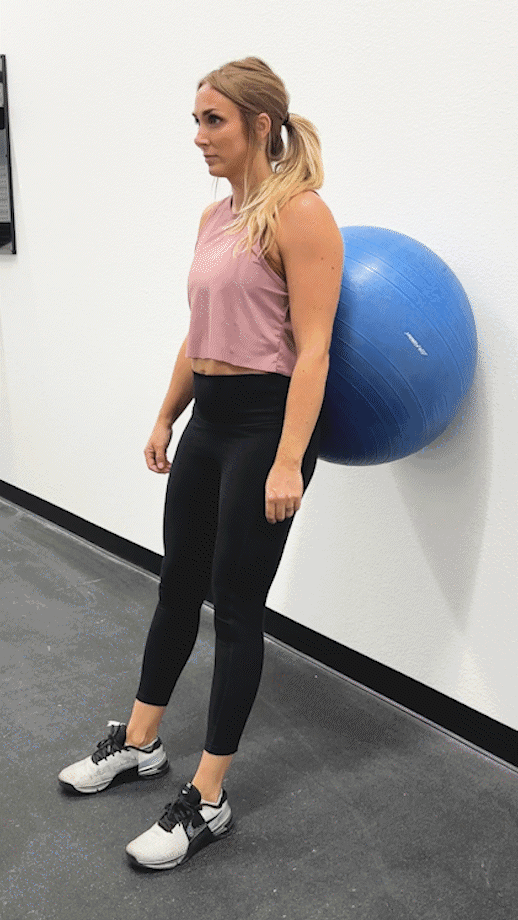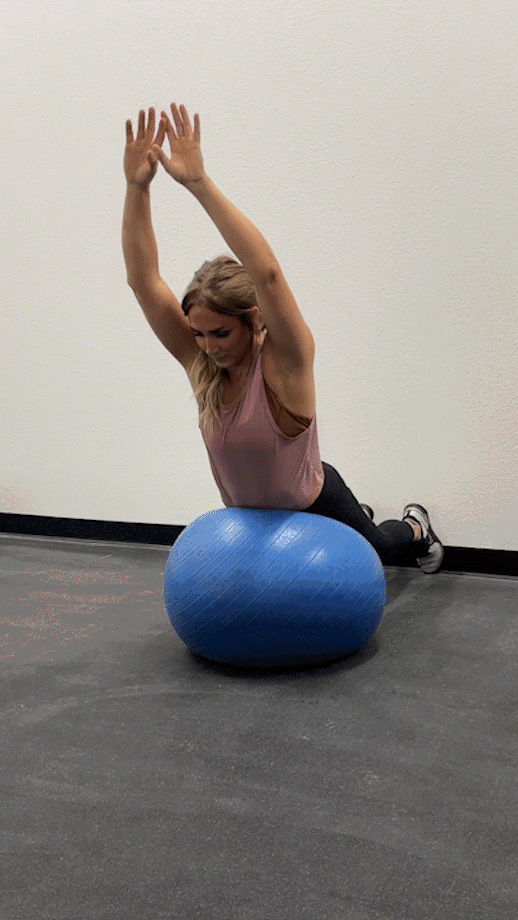Were you gifted a stability ball for Christmas and haven’t managed to take it out of the packaging? Or did you buy one for yourself so you could work out at home, but you’re not quite sure which exercises to do with it?
RELATED: Program Your Own Home Workouts
Fret not. I’m here to help. Like Cinderella, you too shall go to the ball. As a certified personal trainer (CPT), I believe stability balls are an underrated yet effective piece of workout equipment for all fitness levels. There are tons of exercises you can do with one, and doing them regularly can increase your balance, give you core strength, and even help with your posture.
RELATED: Balance Exercises
For this article, I’ll start by explaining how you can pick the right size stability ball for your needs. Then, I’ll go into the 12 best stability ball exercises you can try, finishing with a section on the benefits of adding a stability ball workout to your regular routine.
How to Pick the Right Size Stability Ball
As you know, stability balls come in a range of sizes. It’s important that you pick the right one for your needs.
But how do you do this?
Luckily, you have me, but I also consulted with certified personal trainer (CPT) and GGR Head of Content Kate Meier to get her opinion.

Height is the main factor when it comes to picking the right size stability ball. When seated upright on it, your knees should be at a 90-degree angle and your hips in alignment with your knees1. Below are the general guidelines for you to consider:
- Under 4’6″ (137 cm): 30 cm ball (12″)
- 4’6″–5’0″ (137–152 cm): 45 cm ball (18″)
- 5’1″–5’7″ (155–170 cm): 55 cm ball (22″)
- 5’8″–6’2″ (173–188 cm): 65 cm ball (26″)
- Over 6’2″ (188 cm): 75 cm ball (30″)
“Your weight is also a factor when it comes to picking the correct stability ball,” Kate explains. “Every ball has a weight rating, so if you weigh more than this, you may need to opt for a larger ball.”
The type of exercises you’ll be doing matters, too. A smaller ball is great for performing the best ab exercises but won’t be suitable if you’re looking to mimic a flat bench. You may want to buy two or three different sizes to test them out for various strength training exercises.
RELATED: Best Weight Bench
Best Stability Ball Exercises
Now you know how to pick the right size stability ball, here are the 12 best stability ball exercises for you to try:
1. Stability Ball Hamstring Curl
Why do it: The stability ball hamstring curl helps strengthen the muscles in your lower body without needing dumbbells or barbells.
How to do it:
- Lie down on the floor or an exercise mat, facing upward.
- With your arms by your sides, lift and straighten your legs and place them on the stability ball (your heels and calves should be touching it).
- Engage your core and glutes, then raise your hips off the floor to get into the starting position. Your body should be in a straight line.
- By bending your knees and using the heels of your feet, bring the stability ball as close as possible to your body.
- Pause, then reverse the motion by straightening your legs so the ball moves away from you.
- Continue curling for reps.
Muscles targeted: Hamstrings, glutes, core, calves

2. Stability Ball Floor Taps
Why do it: “For core stability, adding a ball increases the intensity [of this movement] because you’re less stable than you would be if your feet were on the floor,” says Kate.
How to do it:
- Place the stability ball on the floor, then get into the plank position with your toes on top of the ball.
- Looking down at the floor, activate your core and glutes.
- Take your left leg off the ball, and bring it down to the side until your left foot touches the floor.
- Hold, then slowly bring the left toe back onto the stability ball.
- Repeat with the right leg, touching your right foot on the floor.
- Continue for the desired number of reps, using a single leg each time.
Muscles targeted: Core muscles, hip flexors, shoulders

3. Stability Ball Squat
Why do it: Using a stability ball to squat during your home workout can help reduce pressure on your lower back. I also like that it encourages you to keep your body upright throughout the movement.
How to do it:
- Put a stability ball against a wall. You’ll want to position it at a height so it’ll touch the lower to the middle of your back once you’re pressed up against it.
- Facing away from the wall, get into the squat position with your feet slightly wider than shoulder-width apart and the ball behind you.
- Squat down, driving your hips backward while doing so. The fitness ball will roll down with you as you do this.
- When your quads are parallel to the floor, hold the position there. Then, push into the ground with your heels to return to the standing position.
- Keep squatting for reps.
RELATED: Squat Anatomy
Muscles targeted: Quads, hamstrings, glutes, core, calves

4. Stability Ball Preacher Curl
Why do it: The preacher curl is a great exercise for biceps activation, and adding a ball provides an extra challenge because it forces you to stabilize yourself throughout the movement.
How to do it:
- Place a stability ball on top of a flat bench or other solid surface.
- Position your body close to the ball so it’s less likely to move. Then, grab a dumbbell with your left hand and get into the preacher curl position.
- Straighten your left arm until it’s nearly locked out, then slowly curl it back up. Keep going, then switch to your right arm.
- Continue for the desired number of reps on each arm.
Muscles targeted: Biceps, core

5. Stability Ball Cobra
Why do it: Kate says, “The cobra exercise is popular in the yoga and Pilates world because it helps to improve your posture and wellness, especially for those who suffer from stiffness in their back or shoulders.”
How to do it:
- With the stability ball on the floor, get on top of it so it’s touching your abdominal region and you’re looking downwards.
- Completely straighten your legs and position your feet hip-width apart. Your toes are the only thing that should be touching the floor.
- Extend your arms out in front of you to get into the starting position.
- With your core engaged and glutes squeezed, slowly bring your arms to the sides and around so they’re behind your body. Hold them there.
- Return your arms to the extended position in a controlled manner.
- Repeat for repetitions.
Muscles targeted: Lower back, glutes, shoulders, core

6. Stability Ball Superman
Why do it: Adding a stability ball gives you a longer range of motion than you’d get when doing a bodyweight superman on the floor. It’s also a low-impact exercise, so it’s ideal for beginners.
How to do it:
- Place a stability ball on the floor, close to a wall.
- With your heels up against the wall, get on top of the medicine ball so it’s touching your pelvic region. Your body should be in a straight line.
- Place your hands on or at the sides of your forehead.
- Now, slowly drop your body down so your forehead moves towards the stability ball.
- Pause, then reverse the motion so you’re fully extended.
- Repeat for reps.
Muscles targeted: Lower back, glutes, hamstrings

7. Stability Ball Push-Up
Why do it: Push-ups work the entire body. Doing them on a ball will get your heart rate up in no time because you’re balancing on an unstable surface. There are tons of variations too (below is just one of them!), making it an extremely versatile exercise.
How to do it:
- Get into the push-up position with your feet and shins on top of the stability ball while the ball is on the floor. Your palms should be touching the floor.
- Squeeze your glutes and activate your core, and at the same time, tuck your elbows inwards.
- Similar to a regular push-up, bend your elbows so your body moves toward the ground.
- Keep going down until your chest is as close to the floor as possible. Then, go back up.
- Repeat for the desired number of reps.
RELATED: What Muscles Do Push-Ups Work?
Muscles targeted: Chest, shoulders, triceps, upper back, core

8. V-Up with Stability Ball
Why do it: The v-up with stability ball targets the rectus abdominis, obliques, and hip flexor muscles. Strengthening the core can help with other exercises in the gym or at home, and daily activities, as well as reducing pain scores, functional disability, and recurrences of acute low back pain episodes2.
How to do it:
- Lie down on the floor or on top of your exercise mat, facing the ceiling.
- Straighten your legs, then place the ball in between your feet.
- Extend your arms above your head, ensuring they’re touching the floor.
- Engage your core, then lift your arms and legs off the floor at the same time so they move toward each other.
- Grab the ball with your hands, taking it away from your feet. Then, return both your arms and legs toward the floor, straightening them as you do so.
- Repeat, but this time, take hold of the ball with your feet instead.
- Continue for reps.
Muscles targeted: Core, hip flexors

9. Overhead Stability Ball Squat
Why do it: Similar to the stability ball squat above, you’ll be working the majority of your lower body muscles. “You only need a light load for this exercise because there’s a significant distance between the weight and your working muscles,” says Kate.
RELATED: What Muscles Do Squats Work?
How to do it:
- Take hold of an exercise ball and stand upright with your feet slightly wider than shoulder-width apart and your toes pointing slightly outwards.
- Raise your arms above your head, ensuring they stay close to your ears.
- Engage your glutes and core, keep your head neutral, and perform a squat. Drive your hips backward to make the most out of the movement.
- Keep lowering until your thighs are parallel to the floor. When they get there, pause, then push through your heels to return to the standing position.
- Squat for reps, then place the ball on the ground.
Muscles targeted: Hamstrings, quads, glutes, lower back, core

10. Stability Ball Crunches
Why do it: A stability ball is softer than the floor, so I prefer using it to do crunches. If you suffer from low back pain, performing crunches on a ball rather than a resistance machine could be beneficial because it induces high rectus abdominis activity accompanied by low hip flexor activity3.
How to do it:
- Place a stability ball on the floor and sit down as you would on a chair.
- Walk your feet down, and at the same time, lie backward so your lower back is resting on top of the ball.
- Position your feet flat on the floor, ensuring they’re shoulder-width apart. Then, cross your arms over your shoulders.
- Activate your core, then lift your upper body toward the ceiling. Make sure your head is neutral at all times.
- Hold, then lower your body back down to the original position.
- Repeat for reps.
Muscles targeted: Core

11. Stability Ball Back Extension and Twist
Why do it: Kate says, “This exercise helps to strengthen your posterior chain, as well as improve trunk rotation.”
How to do it:
- Place a ball on the floor near a wall.
- Position your heels against the wall, then lie down on the ball, facing the floor. The ball should be touching your pelvic region.
- Squeeze your glutes, then take a dowel rod or a mobility stick with both hands and place it behind your head. This ensures your shoulder blades stay retracted throughout the movement.
- Lower your body towards the floor in a controlled manner. Once you can’t go further, reverse the motion, coming back up.
- When you’re upright, rotate your body to the left side.
- Twist to the center, then do another back extension by lowering your body. This time, rotate to your right side as you come up.
- Continue for the desired number of reps, alternating sides every time.
RELATED: How to Do Back Extensions At Home
Muscles targeted: Lower back muscles, hamstrings, glutes, calves, core

12. Stability Ball Dips
Why do it: I’m a huge fan of this exercise as it really hits the triceps while forcing you to improve your balance and coordination.
How to do it:
- Stand in front of your stability ball while it’s placed on the floor.
- Bend your knees and squat down toward the ball. When you get close to it, place your hands on the ball, one on either side of your body. Your arms should be straight here and your fingers facing forward.
- Make sure your feet are firmly on the ground, then bend your elbows so your body moves toward the floor. Keep your head neutral and stick your chest up.
- Go down as far as possible, pause, then slowly return to the starting position.
- Keep going for reps.
Muscles targeted: Triceps, chest, shoulders, core

Stability Ball Exercises Benefits
Here are three benefits of incorporating stability ball exercises into your training regimen:
1. May Help Improve Balance
If you’re used to flat surfaces such as a bench or the floor to do your exercises, you’re in for a shock. You’ve probably never had to even think about balance before. Well, with a stability ball, you do. If you don’t, you’ll simply fall over. Added to this, a stability ball may help fix muscular imbalances because you can’t dominate the movement with your stronger side.
2. May Help Increase Core Strength
Nearly every dumbbell, barbell, or bodyweight workout in the gym uses the core in some way. The great thing about doing any exercise on a stability ball is that because the ball is unstable (maybe it should be called an instability ball instead?), you need to use your core and stabilizer muscles. Even exercises like the preacher curl which doesn’t typically use the core on a preacher curl machine activates the core as soon as you replace the machine with a ball.

3. May Lead to Better Posture
For those who have desk jobs, pay attention. Exercising with a stability ball can help to improve your posture, reducing the risk of back pain in sedentary individuals4. “Not only will this help you to feel less stiff around the joints, but it’ll also help with day-to-day activities such as walking your dog or lifting your groceries,” Kate says.
Stability Ball Exercises: Final Thoughts
So, by now, I’m hoping you’re tempted to try out some stability ball exercises. It’s a versatile piece of equipment that adds an extra layer of challenge to your workout routine.
The benefits include:
- Better balance
- More core strength
- Improved posture
Remember to warm up by doing some cardio and stretching before you start. And, of course, pick the right size ball for your needs.
RELATED: Best Warm-Up Exercises
Stability Ball Exercises: FAQs
Are stability balls good for exercise?
Yes, stability balls can be a great tool for exercise. I like that you can work your whole body and replace most exercises you would typically do on a flat surface with a ball. This adds an extra challenge while improving your posture and coordination.
What muscles do stability ball exercises work?
Stability ball exercises can work every muscle group in the body. Overhead stability ball squats target the lower body, and stability ball push-ups activate the chest, shoulders, and triceps. There are also a ton of core exercises you can do, including stability ball floor taps and stability ball crunches. There’s no limit when it comes to exercising with stability balls.
What are the benefits of a stability ball?
The benefits of using a stability ball include improvements to your balance, core strength, and posture. Because a ball is less stable than a flat surface such as the floor or a flat bench, you’ll need to use your core and stabilizer muscles to keep balanced throughout each exercise.
What is the Swiss ball core exercise for seniors?
There are many Swiss ball core exercises for seniors that you can try out. Stability ball cobra, stability ball Superman, and stability ball crunches are three examples of lower-impact exercises that use a Swiss ball.
References
- Ace Fit: Strengthen Your Abdominals With Stability Balls. ACE Fit | Strengthen Your Abdominals With Stability Balls. https://www.acefitness.org/resources/everyone/blog/6696/strengthen-your-abdominals-with-stability-balls/. Accessed August 2, 2023.
- Baerga-Varela L, Abréu Ramos AM. Core strengthening exercises for low back pain. Bol Asoc Med P R. 2006 Jan-Mar;98(1):56-61. PMID: 19610550.
- Sundstrup E, Jakobsen MD, Andersen CH, Jay K, Andersen LL. Swiss ball abdominal crunch with added elastic resistance is an effective alternative to training machines. Int J Sports Phys Ther. 2012 Aug;7(4):372-80. PMID: 22893857; PMCID: PMC3414069.
- Carter JM, Beam WC, McMahan SG, Barr ML, Brown LE. The effects of stability ball training on spinal stability in sedentary individuals. J Strength Cond Res. 2006 May;20(2):429-35. doi: 10.1519/R-18125.1. PMID: 16686575.







